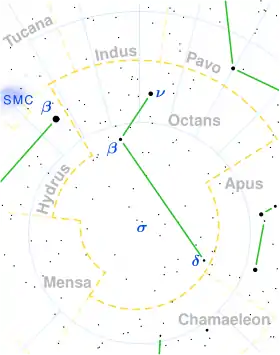Ню Октанта
Октанта (ню Октанта, Octantis) — спектроскопічна подвійна зоря[10] в сузір'ї Октанта. Її видима зоряна величина — 3,73. Розташована приблизно за 20 пк (65 св. р.) від Землі. Головна зоря — помаранчевий гігант спектрального типу K1III. У її ядрі вигорів водень і вона розширилася. Її супутник, швидше за все, — червоний карлик із малою масою. Період обертання в системі становить близько 2,9 років[9].
 Розташування Октанта в сузір'ї обведено червоним | |
| Дані спостереження Епоха J2000 | |
|---|---|
| Сузір’я | Октант |
| Пряме піднесення | 21г 41х 28.64977с[1] |
| Схилення | -77° 23′ 24.1563″[1] |
| Видима зоряна величина (V) | 3.73[2] |
| Характеристики | |
| Спектральний клас | K1III[3] |
| Показник кольору (B−V) | +1.00[4] |
| Показник кольору (U−B) | +0.89[4] |
| Астрометрія | |
| Променева швидкість (Rv) | +34.40[5] км/c |
| Власний рух (μ) | Пр.сх.: +66.41[1] мас/р Схил.: -239.10[1] мас/р |
| Паралакс (π) | 51.5172 ± 0.6525 мас[6] |
| Відстань | 63.3 ± 0.8 св. р. (19.4 ± 0.2 пк) |
| Абсолютна зоряна величина (MV) |
+2.10[2] +2.02[7] |
| Орбіта[7] | |
| Період (P) | 1050.69+0.05 −0.07 діб |
| Велика піввісь (a) | 2.62959+0.00009 −0.00011 а.о.″ |
| Ексцентриситет (e) | 0.23680 ± 0.00007 |
| Нахил (i) | 70.8 ± 0.9° |
| Вузол (Ω) | 87 ± 1.2° |
| Епоха періастру (T) | 74.970 ± 0.016 |
| Півамплітуда (K1) (первинна) | 7.032 ± 0.003 км/с |
| Фізичні характеристики | |
| Маса | 1.04[8] 1.61 / 0.585[7] M☉ |
| Радіус | 5.9[8] 5.81 ± 0.12[7] R☉ |
| Світність | 17.53[2] L☉ |
| Ефективна температура | 4860 ± 40[9] K |
| Інші позначення | |
| Посилання | |
| SIMBAD | дані для nu+Oct |
У 2009 році, ґрунтуючись на збуреннях орбітального періоду, було висунуто гіпотезу, що система містить екзопланети[9]. Можливість їх проградного руху одразу виключили[11], але ретроградний рух залишався можливим, хоча варіації можуть бути пов'язані з тим, що головна зоря сама по собі є подвійною[12], оскільки формування планет в такій системі було б важким через динамічні збурення[13].
| Супутник (у порядку від зорі) |
Маса | Велика піввісь (а.о.) |
Орбітальний період (днів) |
Ексцентриситет | Нахил орбіти | Радіус |
|---|---|---|---|---|---|---|
| b (не підтверджено) | 2.1059 MJ | 1.276 | 414.8 | 0.086 | 112.5° | — |
Примітки
- Van Leeuwen, F. (2007). Validation of the new Hipparcos reduction. Astronomy and Astrophysics 474 (2): 653. Bibcode:2007A&A...474..653V. arXiv:0708.1752. doi:10.1051/0004-6361:20078357. Vizier catalog entry
- Anderson, E.; Francis, Ch. (2012). XHIP: An extended hipparcos compilation. Astronomy Letters 38 (5): 331. Bibcode:2012AstL...38..331A. arXiv:1108.4971. doi:10.1134/S1063773712050015. Vizier catalog entry
- Gray, R. O. та ін. (July 2006). Contributions to the Nearby Stars (NStars) Project: spectroscopy of stars earlier than M0 within 40 pc-The Southern Sample. The Astronomical Journal 132 (1): 161–170. Bibcode:2006AJ....132..161G. arXiv:astro-ph/0603770. doi:10.1086/504637.
- Mallama, A. (2014). Sloan Magnitudes for the Brightest Stars. The Journal of the American Association of Variable Star Observers 42: 443. Bibcode:2014JAVSO..42..443M.Vizier catalog entry
- Wilson, R. E. (1953). General Catalogue of Stellar Radial Velocities. Carnegie Institution for Science. Bibcode:1953GCRV..C......0W. LCCN 54001336.
- Gaia collaboration (August 2018). Gaia Data Release 2. Astronomy & Astrophysics (Summary of the contents and survey properties) 616. A1. Bibcode:2018A&A...616A...1G. arXiv:1804.09365. doi:10.1051/0004-6361/201833051. Gaia DR2 record at VizieR.
- Ramm, D. J. (2016). The conjectured S-type retrograde planet in ν Octantis: more evidence including four years of iodine-cell radial velocities. Monthly Notices of the Royal Astronomical Society 460 (4): 3706–3719. Bibcode:2016MNRAS.460.3706R. arXiv:1605.06720. doi:10.1093/mnras/stw1106.
- Allende Prieto, C.; Lambert, D. L. (1999). Fundamental parameters of nearby stars from the comparison with evolutionary calculations: Masses, radii and effective temperatures. Astronomy and Astrophysics 352: 555. Bibcode:1999A&A...352..555A. arXiv:astro-ph/9911002. Vizier catalog entry
- Ramm, D. J.; Pourbaix, D.; Hearnshaw, J. B.; Komonjinda, S. (April 2009). Spectroscopic orbits for K giants β Reticuli and ν Octantis: what is causing a low-amplitude radial velocity resonant perturbation in ν Oct?. Monthly Notices of the Royal Astronomical Society 394 (3): 1695–1710. Bibcode:2009MNRAS.394.1695R. doi:10.1111/j.1365-2966.2009.14459.x.
- Eggleton, P. P.; Tokovinin, A. A. (September 2008). A catalogue of multiplicity among bright stellar systems. Monthly Notices of the Royal Astronomical Society 389 (2): 869–879. Bibcode:2008MNRAS.389..869E. arXiv:0806.2878. doi:10.1111/j.1365-2966.2008.13596.x.
- Eberle, J.; Cuntz, M. (October 2010). On the reality of the suggested planet in the ν Octantis system. The Astrophysical Journal 721 (2): L168–L171. Bibcode:2010ApJ...721L.168E. doi:10.1088/2041-8205/721/2/L168.
- Morais, M. H. M.; Correia, A. C. M. (February 2012). Precession due to a close binary system: an alternative explanation for ν-Octantis?. Monthly Notices of the Royal Astronomical Society 419 (4): 3447–3456. Bibcode:2012MNRAS.419.3447M. arXiv:1110.3176. doi:10.1111/j.1365-2966.2011.19986.x.
- Gozdziewski, K.; Slonina, M.; Migaszewski, C.; Rozenkiewicz, A. (March 2013). Testing a hypothesis of the ν Octantis planetary system. Monthly Notices of the Royal Astronomical Society 430 (1): 533–545. Bibcode:2013MNRAS.430..533G. arXiv:1205.1341. doi:10.1093/mnras/sts652.
